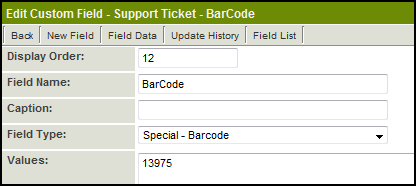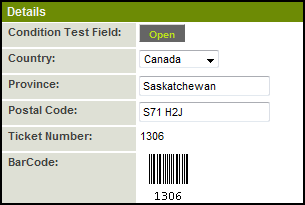Difference between revisions of "Upgrades by Category"
(→Personal Settings) |
|||
| Line 97: | Line 97: | ||
* UTA Transactions can bridge 2 different UTAs, either at Level 1 or at Level 2. | * UTA Transactions can bridge 2 different UTAs, either at Level 1 or at Level 2. | ||
|May 2009 | |May 2009 | ||
| + | |+ | ||
| + | |[[Status#Submit Button Script (Level 1 Only)|Level 1 Submit Button Script]] | ||
| + | * Allows you to define a script that is run when the '''Submit''' button is pressed. The normal Submit button functions are not executed (validation and status change). | ||
| + | * This will allow you to create a [[Custom Field Type: Special – Browser Script|Browser Script]] that will perform custom validation of the data on the page, and can then optionally change the [[status]] or execute the submit function as part of the script. | ||
| + | |July 2009 | ||
| + | |+ | ||
| + | |[[Status#Status Settings|Level 2 and Level 3 Submitted URL]] | ||
| + | * When the Submit button is pressed for a given [[Status]], instead of remaining on the view of the current record the [[User|user]] will be redirected to the [[URL]] defined in this section. If no [[URL]] is entered the current record will stay in view. | ||
| + | * This was introduced for Level 1 in the last upgrade, and now has expanded to include Level 2 and Level 3. | ||
| + | |July 2009 | ||
| + | |+ | ||
| + | |[[Types#Type Settings|Level 2 Type Tab Label]] | ||
| + | * Currently you can configure Level 2 Types to be shown on their own tab in the list view at the bottom of Level 1 records, with each tab labelled with the name of the Level 2 Type it contains. | ||
| + | * Following this upgrade you will be able to define the tab name for any Types that you wish to have on tabs. If you use the same tab name for multiple Types they will appear on the same tab, allowing you to group related Level 2 Types. | ||
| + | |July 2009 | ||
| + | |+ | ||
| + | |[[Skills Matching Template]] | ||
| + | * There are now 2 different types of [[Level 1 Templates]] available. In addition to the Standard Template there is now a '''Skills Matching Template'''. | ||
| + | * The Skills Matching Template allows you to define a set of skills that are related to a particular Level 1 record. In the Contact section of that record a '''Skills Match''' button will appear which will allow you to find contacts that have the relevant skills defined for that [[Entity|entity]]. | ||
| + | * ''For example, if the Level 1 record is a funding application for a project researching whale migration patterns you may want to assign reviewers with skills in oceanography, marine biology and meteorology.'' | ||
| + | |July 2009 | ||
| + | |+ | ||
| + | |[[Advanced Logic|Advanced Logic to Suppress Contact Hyperlinks]] | ||
| + | * Using [[Advanced Logic]] you are now able to suppress the Contacts hyperlink at Level 1. | ||
| + | * This allows you to define criteria to prevent [[UTA]] [[User|users]] from clicking into and viewing the contact record for contacts associated with a Level 1 record. | ||
| + | |July 2009 | ||
|} | |} | ||
| + | |||
| + | |||
===Calendars=== | ===Calendars=== | ||
Revision as of 11:35, 30 April 2013
Contents
Security Enhancements
| Feature | Upgrade Date | Password Expiration You can now set a system-wide password expiration number of days. Each user will be forced to change their password once that number of days has passed. |
April 2009 | Password History You can set the number of previous passwords (to a maximum of 32) that the system will remember for each user. When changing their password, users will not be permitted to re-use a previous password until the specified number of unique passwords has been used. |
April 2009 | Instance Lock-Down
|
May 2009 | Remove User Access
|
May 2009 | Terminate User Session
|
May 2009 |
|---|
UTA Enhancements
| Feature | Upgrade Date | Standard Field Visibility Control
|
April 2009 | Level 1: Tabs for Contact and Account Lists
|
April 2009 | Level 1: UTA Contact and Account Filters
|
April 2009 | Level 1: Contact Restrictions
|
April 2009 | Level 2: Multiple Contact List
If you enable the Use Multiple Contact List checkbox on the Settings > Application Configuration screen you will be able to associate and control contact associations in a similar manner to Level 1 contacts. |
April 2009 | Level 2: Multiple Account List
If you enable the Use Multiple Account List checkbox on the Settings > Application Configuration screen you will be able to associate and control account associations in a similar manner to Level 1 contacts. |
April 2009 | Level 2: Role Filtering
You can restrict the selection of contacts that can be associated with Level 2 items by role. Previously you could only restrict by specified named contacts. An additional lookup text area has been added the bottom of the Level 2 Types Settings page to specify the roles. |
April 2009 | Disabling Specific Transaction Types by Template
|
April 2009 | Level 3 Template Formulas
You can now associate template formulas with Level 3 items in the same manner as Level 2 and Level 1 items. |
April 2009 | Submitted URL Redirect
|
May 2009 | Suppress New Level 2 or Level 3 Buttons
|
May 2009 | Batch Update Owner Field
|
May 2009 | Cross-UTA Transactions
|
May 2009 | Level 1 Submit Button Script
|
July 2009 | Level 2 and Level 3 Submitted URL
|
July 2009 | Level 2 Type Tab Label
|
July 2009 | Skills Matching Template
|
July 2009 | Advanced Logic to Suppress Contact Hyperlinks
|
July 2009 |
|---|
Calendars
| Feature | Upgrade Date | Recurring Calendar Events
|
May 2009 |
|---|
Custom Fields
| Feature | Upgrade Date | Auto Save Custom Field
|
May 2009 | Bar Code Custom Field
In the above example 13975 is the Custom Field ID of the "Ticket Number" field, which would display on the record as: |
May 2009 | Custom Field Tabs
In the above example there are 3 tabs named "Additional Details", "Company Information" and "Contract Details" Navigation between the tabs can be accomplished by either clicking on the Next or Previous buttons, or by clicking on the name of the tab you wish to access. |
May 2009 | MS Word Merge Enhancement
|
May 2009 |
|---|
Document Management
| Feature | Upgrade Date | MS Word Merge Custom Field
|
April 2009 | Allow Merging of PDF Documents
|
April 2009 | Multiple File Field: Display Additional File Attributes for PDF Documents
|
April 2009 | Single File Field: Display Additional File Attributes for PDF Documents
|
April 2009 |
|---|
Personal Settings
| Feature | Upgrade Date | Time Format
|
May 2009 |
|---|
SmartFolders
| Feature | Upgrade Date | Inclusion of Folders in Search
|
May 2009 |
|---|
Web Forms
| Feature | Upgrade Date | Web Form Status
|
May 2009 | Convert Web Form to PDF
|
May 2009 |
|---|
Workflows
| Feature | Upgrade Date | Level 2 Creation
|
May 2009 | HTML E-mail Format
|
May 2009 |
|---|



